Navonil Majumder
JAM: A Tiny Flow-based Song Generator with Fine-grained Controllability and Aesthetic Alignment
Jul 28, 2025Abstract:Diffusion and flow-matching models have revolutionized automatic text-to-audio generation in recent times. These models are increasingly capable of generating high quality and faithful audio outputs capturing to speech and acoustic events. However, there is still much room for improvement in creative audio generation that primarily involves music and songs. Recent open lyrics-to-song models, such as, DiffRhythm, ACE-Step, and LeVo, have set an acceptable standard in automatic song generation for recreational use. However, these models lack fine-grained word-level controllability often desired by musicians in their workflows. To the best of our knowledge, our flow-matching-based JAM is the first effort toward endowing word-level timing and duration control in song generation, allowing fine-grained vocal control. To enhance the quality of generated songs to better align with human preferences, we implement aesthetic alignment through Direct Preference Optimization, which iteratively refines the model using a synthetic dataset, eliminating the need or manual data annotations. Furthermore, we aim to standardize the evaluation of such lyrics-to-song models through our public evaluation dataset JAME. We show that JAM outperforms the existing models in terms of the music-specific attributes.
Lessons from Training Grounded LLMs with Verifiable Rewards
Jun 18, 2025Abstract:Generating grounded and trustworthy responses remains a key challenge for large language models (LLMs). While retrieval-augmented generation (RAG) with citation-based grounding holds promise, instruction-tuned models frequently fail even in straightforward scenarios: missing explicitly stated answers, citing incorrectly, or refusing when evidence is available. In this work, we explore how reinforcement learning (RL) and internal reasoning can enhance grounding in LLMs. We use the GRPO (Group Relative Policy Optimization) method to train models using verifiable outcome-based rewards targeting answer correctness, citation sufficiency, and refusal quality, without requiring gold reasoning traces or expensive annotations. Through comprehensive experiments across ASQA, QAMPARI, ELI5, and ExpertQA we show that reasoning-augmented models significantly outperform instruction-only variants, especially in handling unanswerable queries and generating well-cited responses. A two-stage training setup, first optimizing answer and citation behavior and then refusal, further improves grounding by stabilizing the learning signal. Additionally, we revisit instruction tuning via GPT-4 distillation and find that combining it with GRPO enhances performance on long-form, generative QA tasks. Overall, our findings highlight the value of reasoning, stage-wise optimization, and outcome-driven RL for building more verifiable and reliable LLMs.
NORA: A Small Open-Sourced Generalist Vision Language Action Model for Embodied Tasks
Apr 28, 2025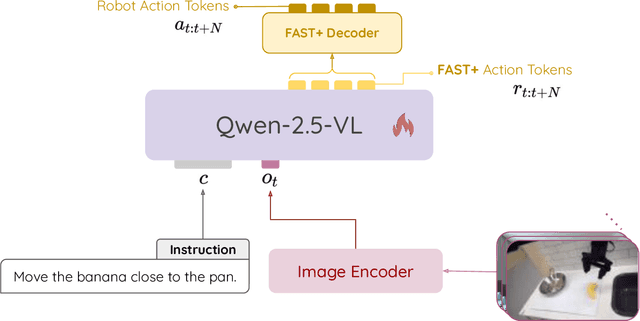
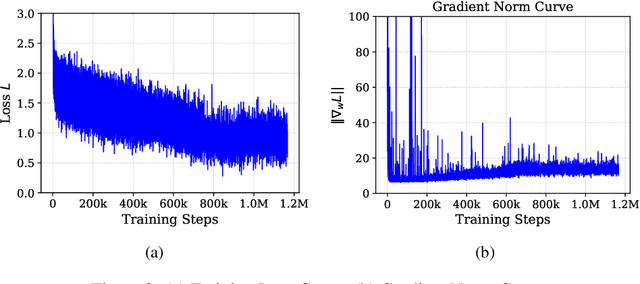

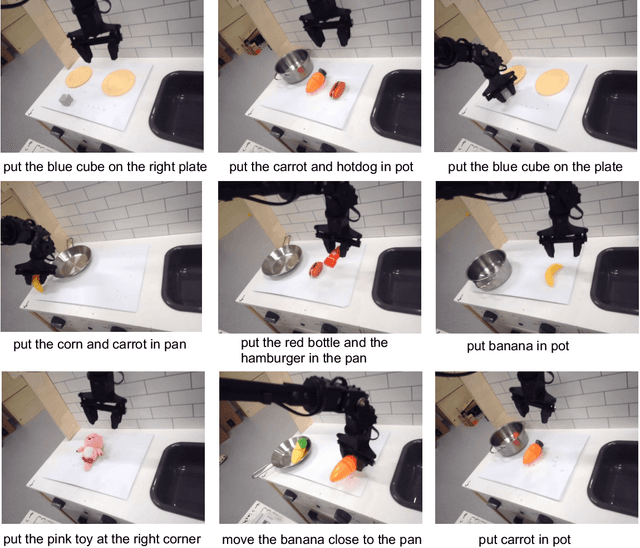
Abstract:Existing Visual-Language-Action (VLA) models have shown promising performance in zero-shot scenarios, demonstrating impressive task execution and reasoning capabilities. However, a significant challenge arises from the limitations of visual encoding, which can result in failures during tasks such as object grasping. Moreover, these models typically suffer from high computational overhead due to their large sizes, often exceeding 7B parameters. While these models excel in reasoning and task planning, the substantial computational overhead they incur makes them impractical for real-time robotic environments, where speed and efficiency are paramount. To address the limitations of existing VLA models, we propose NORA, a 3B-parameter model designed to reduce computational overhead while maintaining strong task performance. NORA adopts the Qwen-2.5-VL-3B multimodal model as its backbone, leveraging its superior visual-semantic understanding to enhance visual reasoning and action grounding. Additionally, our \model{} is trained on 970k real-world robot demonstrations and equipped with the FAST+ tokenizer for efficient action sequence generation. Experimental results demonstrate that NORA outperforms existing large-scale VLA models, achieving better task performance with significantly reduced computational overhead, making it a more practical solution for real-time robotic autonomy.
TangoFlux: Super Fast and Faithful Text to Audio Generation with Flow Matching and Clap-Ranked Preference Optimization
Dec 30, 2024Abstract:We introduce TangoFlux, an efficient Text-to-Audio (TTA) generative model with 515M parameters, capable of generating up to 30 seconds of 44.1kHz audio in just 3.7 seconds on a single A40 GPU. A key challenge in aligning TTA models lies in the difficulty of creating preference pairs, as TTA lacks structured mechanisms like verifiable rewards or gold-standard answers available for Large Language Models (LLMs). To address this, we propose CLAP-Ranked Preference Optimization (CRPO), a novel framework that iteratively generates and optimizes preference data to enhance TTA alignment. We demonstrate that the audio preference dataset generated using CRPO outperforms existing alternatives. With this framework, TangoFlux achieves state-of-the-art performance across both objective and subjective benchmarks. We open source all code and models to support further research in TTA generation.
Measuring and Enhancing Trustworthiness of LLMs in RAG through Grounded Attributions and Learning to Refuse
Sep 17, 2024



Abstract:LLMs are an integral part of retrieval-augmented generation (RAG) systems. While many studies focus on evaluating the quality of end-to-end RAG systems, there is a lack of research on understanding the appropriateness of an LLM for the RAG task. Thus, we introduce a new metric, Trust-Score, that provides a holistic evaluation of the trustworthiness of LLMs in an RAG framework. We show that various prompting methods, such as in-context learning, fail to adapt LLMs effectively to the RAG task. Thus, we propose Trust-Align, a framework to align LLMs for higher Trust-Score. LLaMA-3-8b, aligned with our method, significantly outperforms open-source LLMs of comparable sizes on ASQA (up 10.7), QAMPARI (up 29.2) and ELI5 (up 14.9). We release our code at: https://github.com/declare-lab/trust-align.
Reward Steering with Evolutionary Heuristics for Decoding-time Alignment
Jun 25, 2024



Abstract:The widespread applicability and increasing omnipresence of LLMs have instigated a need to align LLM responses to user and stakeholder preferences. Many preference optimization approaches have been proposed that fine-tune LLM parameters to achieve good alignment. However, such parameter tuning is known to interfere with model performance on many tasks. Moreover, keeping up with shifting user preferences is tricky in such a situation. Decoding-time alignment with reward model guidance solves these issues at the cost of increased inference time. However, most of such methods fail to strike the right balance between exploration and exploitation of reward -- often due to the conflated formulation of these two aspects - to give well-aligned responses. To remedy this we decouple these two aspects and implement them in an evolutionary fashion: exploration is enforced by decoding from mutated instructions and exploitation is represented as the periodic replacement of poorly-rewarded generations with well-rewarded ones. Empirical evidences indicate that this strategy outperforms many preference optimization and decode-time alignment approaches on two widely accepted alignment benchmarks AlpacaEval 2 and MT-Bench. Our implementation will be available at: https://darwin-alignment.github.io.
Improving Text-To-Audio Models with Synthetic Captions
Jun 18, 2024



Abstract:It is an open challenge to obtain high quality training data, especially captions, for text-to-audio models. Although prior methods have leveraged \textit{text-only language models} to augment and improve captions, such methods have limitations related to scale and coherence between audio and captions. In this work, we propose an audio captioning pipeline that uses an \textit{audio language model} to synthesize accurate and diverse captions for audio at scale. We leverage this pipeline to produce a dataset of synthetic captions for AudioSet, named \texttt{AF-AudioSet}, and then evaluate the benefit of pre-training text-to-audio models on these synthetic captions. Through systematic evaluations on AudioCaps and MusicCaps, we find leveraging our pipeline and synthetic captions leads to significant improvements on audio generation quality, achieving a new \textit{state-of-the-art}.
Tango 2: Aligning Diffusion-based Text-to-Audio Generations through Direct Preference Optimization
Apr 16, 2024



Abstract:Generative multimodal content is increasingly prevalent in much of the content creation arena, as it has the potential to allow artists and media personnel to create pre-production mockups by quickly bringing their ideas to life. The generation of audio from text prompts is an important aspect of such processes in the music and film industry. Many of the recent diffusion-based text-to-audio models focus on training increasingly sophisticated diffusion models on a large set of datasets of prompt-audio pairs. These models do not explicitly focus on the presence of concepts or events and their temporal ordering in the output audio with respect to the input prompt. Our hypothesis is focusing on how these aspects of audio generation could improve audio generation performance in the presence of limited data. As such, in this work, using an existing text-to-audio model Tango, we synthetically create a preference dataset where each prompt has a winner audio output and some loser audio outputs for the diffusion model to learn from. The loser outputs, in theory, have some concepts from the prompt missing or in an incorrect order. We fine-tune the publicly available Tango text-to-audio model using diffusion-DPO (direct preference optimization) loss on our preference dataset and show that it leads to improved audio output over Tango and AudioLDM2, in terms of both automatic- and manual-evaluation metrics.
Stuck in the Quicksand of Numeracy, Far from AGI Summit: Evaluating LLMs' Mathematical Competency through Ontology-guided Perturbations
Jan 17, 2024Abstract:Recent advancements in Large Language Models (LLMs) have showcased striking results on existing logical reasoning benchmarks, with some models even surpassing human performance. However, the true depth of their competencies and robustness, in mathematical reasoning tasks, remains an open question. In response, we develop (i) an ontology of perturbations of maths questions, (ii) a semi-automatic method of perturbation, and (iii) a dataset of perturbed maths questions to probe the limits of LLM capabilities in mathematical reasoning tasks. These controlled perturbations span across multiple fine dimensions of the structural and representational aspects of maths questions. Using GPT-4, we generated the MORE dataset by perturbing randomly selected five seed questions from GSM8K. This process was guided by our ontology and involved a thorough automatic and manual filtering process, yielding a set of 216 maths problems. We conducted comprehensive evaluation of both closed-source and open-source LLMs on MORE. The results show a significant performance drop across all the models against the perturbed questions. This strongly suggests that current LLMs lack robust mathematical skills and deep reasoning abilities. This research not only identifies multiple gaps in the capabilities of current models, but also highlights multiple potential directions for future development. Our dataset will be made publicly available at https://huggingface.co/datasets/declare-lab/GSM8k_MORE.
Mustango: Toward Controllable Text-to-Music Generation
Nov 14, 2023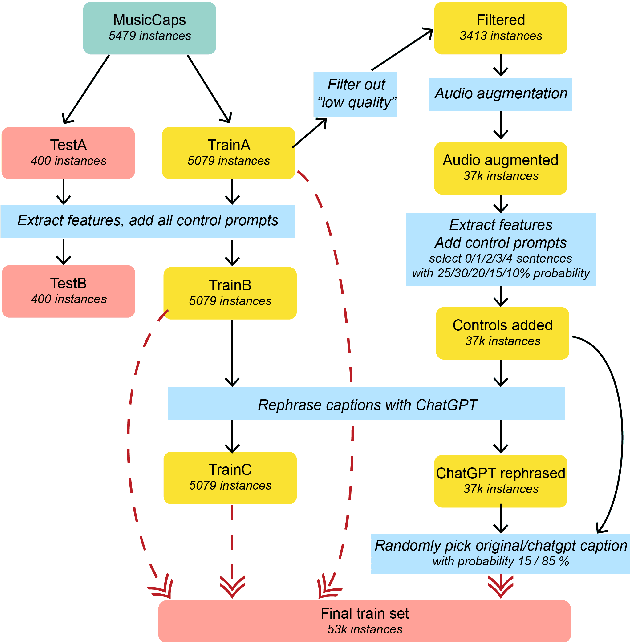

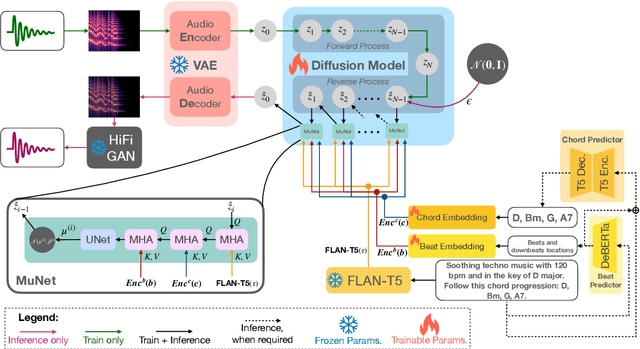

Abstract:With recent advancements in text-to-audio and text-to-music based on latent diffusion models, the quality of generated content has been reaching new heights. The controllability of musical aspects, however, has not been explicitly explored in text-to-music systems yet. In this paper, we present Mustango, a music-domain-knowledge-inspired text-to-music system based on diffusion, that expands the Tango text-to-audio model. Mustango aims to control the generated music, not only with general text captions, but from more rich captions that could include specific instructions related to chords, beats, tempo, and key. As part of Mustango, we propose MuNet, a Music-Domain-Knowledge-Informed UNet sub-module to integrate these music-specific features, which we predict from the text prompt, as well as the general text embedding, into the diffusion denoising process. To overcome the limited availability of open datasets of music with text captions, we propose a novel data augmentation method that includes altering the harmonic, rhythmic, and dynamic aspects of music audio and using state-of-the-art Music Information Retrieval methods to extract the music features which will then be appended to the existing descriptions in text format. We release the resulting MusicBench dataset which contains over 52K instances and includes music-theory-based descriptions in the caption text. Through extensive experiments, we show that the quality of the music generated by Mustango is state-of-the-art, and the controllability through music-specific text prompts greatly outperforms other models in terms of desired chords, beat, key, and tempo, on multiple datasets.
 Add to Chrome
Add to Chrome Add to Firefox
Add to Firefox Add to Edge
Add to Edge